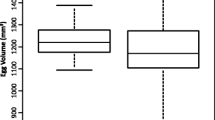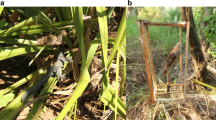Summary
As part of continuing studies of sociality in the wren genus Campylorhynchus we have been studying the bicolored wren — a facultatively cooperative breeder — for the past 6 years in the central Venezuelan savanna. Reproductive groups have ranged in size from 2 to 5. In one of our study populations, only about 15% of the groups contained helpers, and nearly all these contained only a single male helper (Fig. 2). In an adjacent population, the majority of groups contained helpers, and more than half of these contained several helpers of either sex. Territory size is, on average, much smaller in the latter population. In these populations the presence of a single helper is associated with a three-fold increase in reproductive success (Table 1). Additional helpers are not associated with further reproductive enhancement. Enhancement is chiefly due to an increased proportion of nest starts that eventually produce independent juveniles. This reproductive enhancement is not merely an epiphenomenon resulting from the presence of helpers on territories which are superior for other reasons, such as greater resource availability or the quality of particular parents. It is also not a function of the mean or variance in nestling feeding rate. Predator exclusion experiments, in which certan nests were artificially protected from terrestrial predators, suggested that the mechanism of reproductive enhancement was heightened effectiveness of nest defense. Helpers are usually nondispersers from the parental territory, and have always been found to be close relative of the nestlings that they assist in rearing.
Similar content being viewed by others
References
Altmann SA (1974) Baboons, space, time, and energy. Am Zool 14:221–248
Brown JL (1974) Alternate routes to sociality in jays — with a theory for the evolution of altruism and communal breeding. Am Zool 14:63–80
Brown JL (1978) Avian communal breeding systems. Arnu Rev Ecol Syst 9:123–156
Brown JL (1980) Fitness in complex avian social systems. In: Markl H (ed) Evolution of social behavior: hypotheses and empirical tests. Dahlem Konferenzen. Verlag Chemie, Weinheim, pp 115–128
Brown JL (1983) Cooperation — a biologist's dilemma. Adv Study Behav 13:1–37
Craig JL (1980) Pair and group breeding behaviour of a communal gallinule, the pukeko, Porphyrio p. melanotus. Anim Behav 28:593–603
Emlen ST (1978) The evolution of cooperative breeding in birds. In: Krebs JR, Davies NB (eds) Behavioural ecology, Blackwell, Oxford, pp 245–281
Emlen ST, Vehrencamp SL (1983) Cooperative breeding strategies among birds. In: Perspectives in ornithology. Brush AH, Clark GA (eds) Cambridge University Press, Cambridge, pp 93–120
Greenwood PJ (1980) Mating systems, philopatry, and dispersal in birds and mammals. Anim Behav 28:1140–1162
Greenwood PJ, Harvey PH (1982) The natal and breeding dispersal of birds. Annu Rev Ecol Syst 13:1–21
Hamilton WD (1964) The genetical evolution of social behavior. I, II. J Theor Biol 7:1–51
Koenig WD, Pitelka FA (1981) Ecological factors and kin selection in the evolution of cooperative breeding in birds. In: Alexarder RD, Tinkle D (eds) Natural selection and social behavior. Chiron, New York, pp 261–280
Lack D (1968) Ecological adaptations for breeding in birds. Methuen, London
Rabenold KN (1984) Cooperative enhancement of reproductive success in tropical wren societies. Ecology 65:871–885
Rabenold KN (1985) Cooperation in breeding by nonreproductive wrens: kinship, reciprocity, and demography. Behav Ecol Sociobiol 17:1–17
Rabenold KN, Christensen CR (1979) Effects of aggregation on feeding and survival in a communal wren. Behav Ecol Sociobiol 6:39–44
Reyer HU (1980) Flexible helper structure as an ecological adaptation in the pied kingfisher (Ceryle rudis rudis L.). Behav Ecol Sociobiol 6:219–227
Ricklefs RE (1975) The evolution of cooperative breeding in birds. Ibis 117:531–534
Selander RK (1964) Speciation in wrens of the genus Campylorhynchus. Univ Calif Publ Zool 74:1–305
Skutch AF (1961a) Helpers among birds. Condor 63:198–226
Skutch, AF (1961b) The nest as dormitory. Ibis 103:50–70
Skutch AF (1976) Parent birds and their young. University of Texas, Austin London
Snow DW (1962) A field study of the black and white manakin, Manacus manacus, in Trinidad. Zoologica 47:65–104
Stacey PB (1979) Habitat saturation and communal breeding in the acorn woodpecker. Anim Behav 27:1153–1166
Thomas BT (1979) The birds of a ranch in the venezuelan Ilanos. In: Eisenberg JF (ed) Vertebrate ecology in the northern neotropics. Smithsonian, Washington, DC, pp 213–232
Trivers RL (1971) The evolution of reciprocal altruism. Q Rev Biol 46:35–57
Troth RG (1979) Vegetational types on a ranch in the central llanos of Venezuela. In: Eisenberg JF (ed) Vertebrate ecology in the northern neotropics. Smithosonian, Washington, DC, pp 17–30
Vehrencamp SL (1979) The roles of individual, kin, and group selection in the evolution of sociality. In: Marler P, Vandenbergh JG (eds) Handbook of behavioral neurobiology, vol 3. Plenum, New York, pp 351–394
Waser PM, Jones WT (1983) Natal philopatry among solitary mammals. Q Rev Biol 58:355–390
West-Eberhard MJ (1975) The evolution of social behavior by kin selection. Q Rev Biol 50:1–33
Wiley RH, Rabenold KN (1984) The evolution of cooperative breeding by delayed reciprocity and queuing for favorable socia position. Evolution 38(3):609–621
Wiley RH, Wiley MS (1977) Recognition of neighbors' duets by stripe-backed wrens, Campylorhynchus nuchalis. Behaviour 62:10–34
Author information
Authors and Affiliations
Rights and permissions
About this article
Cite this article
Austad, S.N., Rabenold, K.N. Reproductive enhancement by helpers and an experimental inquiry into its mechanism in the bicolored wren. Behav Ecol Sociobiol 17, 19–27 (1985). https://doi.org/10.1007/BF00299423
Received:
Accepted:
Issue Date:
DOI: https://doi.org/10.1007/BF00299423




